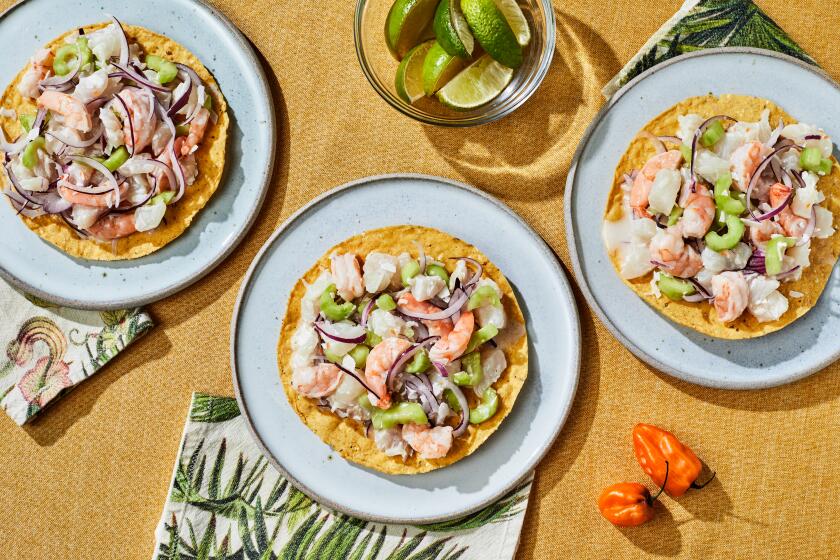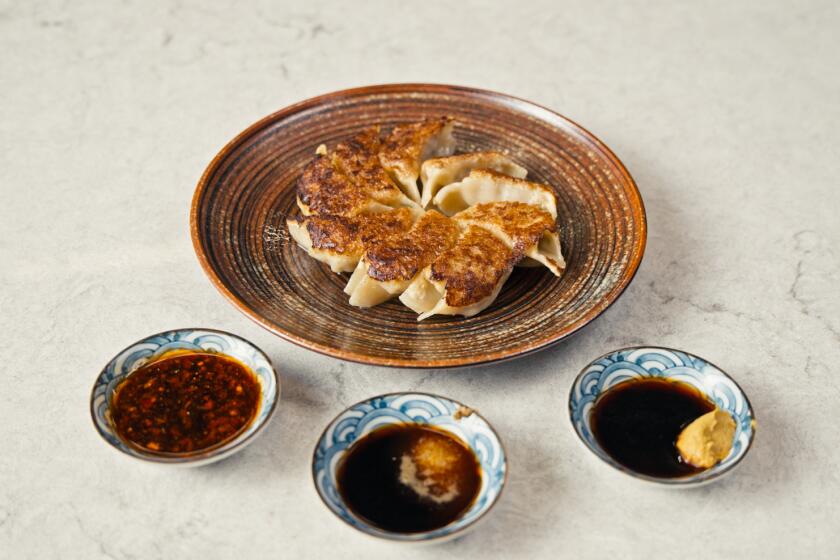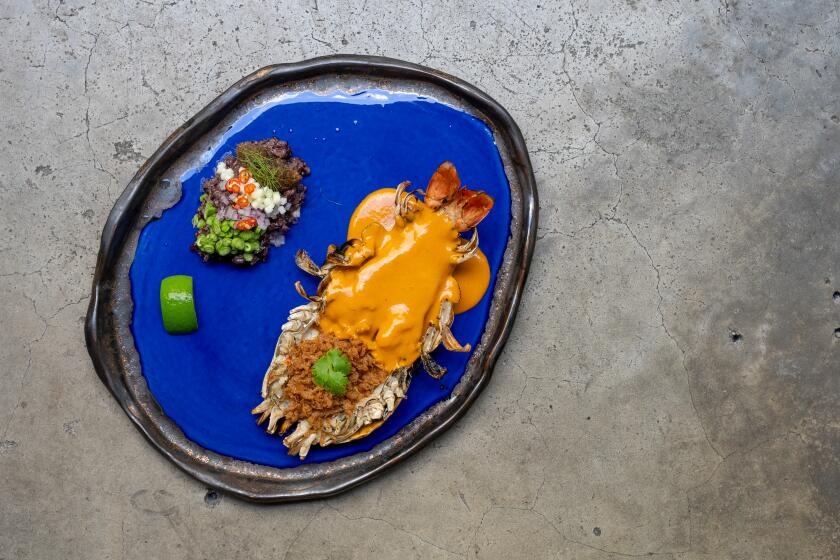Marinated artichokes
Not too long ago my wife and I rented a house for the weekend in the seaside dunes north of Monterey. Out the front window all we could see was the ocean, seemingly just yards away. There wasn’t a back window, but if there had been one, all we would’ve seen was a sea of artichokes -- acres and acres of them.
The ocean was beautiful, of course. But I kept finding myself wondering what was going on out back.
For years, I’ve been fascinated by artichokes. And while I understand that my passion is not universal, I think that’s more a function of other people not understanding how wonderful these vegetables truly are (as opposed to being just another of my food monomanias).
As I see it, the problem is one of preparation (the artichoke’s, not the cook’s). Most people’s artichoke repertoire is limited to two recipes: boiled or steamed.
There is nothing wrong with either of these. I had a steamed artichoke just recently -- my first in years, actually -- and it was very nice indeed, especially with a little herbal mayonnaise in the center.
But there is more to the artichoke than a handy dip holder. And with the last meal of our vacation coming up, it seemed the perfect opportunity to explore some of those possibilities.
The friends with whom we were sharing the house were all wine pros, so there was going to be some pretty nice stuff served. Because of that, I thought it would be best to use the artichokes for appetizers, where they’d be paired with a really fresh Fino Sherry. Artichokes contain a chemical, cynarin, which makes everything taste sweeter. This is death on most wines, but Fino can stand up to just about anything.
But restricting them to appetizers eliminated a couple of my favorite artichoke preparations. I like to braise them as a side dish (quarter, cook over medium heat in a covered pan with oil and water, garlic and parsley, until tender; remove the lid, turn up the heat and cook off the liquid until the artichokes begin to brown).
For the same reason, risotto and pasta were out of the picture.
I thought about doing some marinated artichokes, a spin on the old French a la grecque technique, but since there would be some pickled fish as well (those amazing little Spanish boquerones), that seemed a little much.
For a while I was pretty excited about making one of those salads of shaved raw artichokes. Yeah! Yeah! That’s the ticket! And for a finishing touch, I could serve it in frico cups.
At its most basic, frico is like a potato chip made from Parmesan cheese. The cups couldn’t be simpler to make, and they are delicious (well, fried Parmesan ... how could they be bad?). They are also shapeable when warm, like a tuile. Drape the hot chips over a shot glass or a cork and they’ll cool into a nice little cup.
Despite my exuberance, I did recognize that raw artichokes are an acquired taste, so I made up a little sample of the salad to try on my wife. “These are raw artichokes,” she said, her tone of voice making it clear that she did not mean that in a nice way.
“But I’ll serve them in frico cups,” I pleaded -- if there’s anything that can swing a family food argument my way, it’s the prospect of fried cheese.
“Maybe some other time,” she said, sipping her Champagne.
So it was back to the drawing board, but this time with the Parmesan chips stuck firmly in my mind. Well, I thought, if we’re going to do one fried appetizer, why not two?
So I cleaned another couple of artichokes and cut one in quarters and one in eighths. I filled a pan with about an inch of olive oil, just enough to float the chokes. I drained the artichokes and patted them dry. Then just to make sure there was no water on the surface, I dusted them very lightly with flour, shaking them in a strainer to get rid of any excess.
When the oil was hot, I dropped in a handful of the artichokes. There really are few pleasures in cooking that can compare to the merry whoosh of hot oil that good frying produces. It’s even better when you’re doing it in somebody else’s house so you know you won’t have to smell it for the next several days.
When the artichokes were well-bronzed, I retrieved them, patted them dry and sprinkled them with salt. The quartered chokes were good -- crisp with a perfectly steamed center. But I liked the thinner ones even better, particularly for serving with the frico. They were practically weightless, the high heat of the frying having dried all the interior moisture. It was like taking a bite of crisp, artichoke-flavored air.
These recipes have the advantage of using baby and medium-sized artichokes, which can be a real steal. Baby artichokes are about the size of large eggs; mediums are about the size of a man’s fist.
There is nothing infantile about the babies. Every plant throws up a variety of sizes of artichokes. There will be only a couple of the biggies. Because they are scarce, they are expensive, $2 a piece and up.
There will be several more mediums and many more babies, and their plenty is reflected in their price. I almost never recommend individual stores, but one of the best buys in food right now is at Trader Joe’s, where -- thanks to an arrangement with the Ocean Mist growers’ cooperative, they’re selling four medium artichokes for $1.69 and 2-pound bins of babies for $1.89. That’s less than a quarter the price of anyplace else.
And that’s almost as good as having a whole field of them at your back door.
Slice the onions in 1/2-inch rings, keeping the rings whole as much as possible. Put them in a large skillet and cover them with the oil. Cook over low heat 15 minutes.
Pare the artichokes as described, leaving them whole and keeping them in a bowl of lemon water until ready to use.
Add the carrot and garlic to the onions, cover and cook over low heat until the onions are softened, 15 minutes more.
Add the artichokes to the skillet, cover and cook over low heat 5 minutes.
While the artichokes are cooking, combine the fennel seeds, peppercorns, salt, bay leaves, vinegar and wine in a small saucepan and bring to a full boil. Pour the mixture over the artichokes in the skillet and add enough water so the liquid comes about 2/3 of the way up the sides of the artichokes. Cover and cook at a fast simmer until the artichokes are tender enough that a small sharp knife penetrates the base easily, about 20 minutes.
With a slotted spoon, remove the artichokes to a bowl. Increase the heat to high and cook until the liquid has reduced to a light syrup. You’ll know it’s done when the liquid barely covers the bottom of the pan and begins to stick slightly.
Pour the liquid over the vegetables, cover tightly and refrigerate about 30 minutes or until ready to use. The artichokes are best served cool, or at room temperature.
Get our Cooking newsletter.
Your roundup of inspiring recipes and kitchen tricks.
You may occasionally receive promotional content from the Los Angeles Times.
















